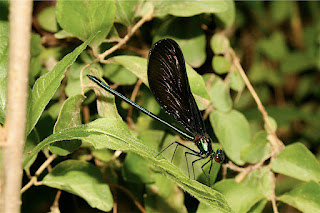On my last blog I showed pictures I had saved from January through April of 2011. Let me continue now with May of 2011.
To start off this month, here is a handsome big spider called Dolomedes scriptus. It's one of the large fishing spiders, usually closely associated with water, and capable of catching small fish and tadpoles.
Here is a male Oklahoma Clubtail, Gomphus oklahomensis, another early dragonfly. On this species even the male has only a small club.
The spectacular hornet-mimicking robber fly, Laphria saffrana, is from the spectacular mostly bumble bee-mimicking genus Laphria. We'll probably see several more Laphria species through the year.
On this one, the death's head marking on the thorax seems appropriate.
I saw these nymphs of the Eastern Lubber Grasshopper (Romalea microptera) in the southwest corner of the state, the only place they are found in Arkansas. I didn't manage to get down there later at the right time to see the even more colorful adults.
The Rough Green Snake is a tiny harmless creature that nevertheless is a relative of the often venomous tropical vine snakes. Normally it is out of sight up in the trees, but it had to come down here to cross the road.
Southern Spreadwing Damselfly, Lestes australis.
Buck Moth caterpillar. If you brush past him, it will be like brushing past stinging nettles, and every spot where spines broke off in your skin will leave the mark of a little hemorrhage the next day.
We sometimes (in this insect-centered blog) take pictures of warm-blooded vertebrates, but only when they insist on plonking themselves down right in front of us. This is a bittern, trying to make himself invisible in the grass, blowing back and forth with the wind to look even more like the grass.
2011, if any of you remember, was the year of the Thirteen-year Cicada. For months we hardly went anywhere without hearing them. After living underground for thirteen years feeding on tree roots they finally come up for their brief moment in the sun. They have no fear reflex and do nothing to resist being eaten by whatever predator is interested. There are so many millions of them all at once, that everything can eat them to satiety, and there are still millions left to sing and mate and lay their eggs before dying off in long windrows.
Stillwater Clubtail, Arigomphus lentulus. This is the only Arigomphus with blue eyes. There are two more Arigomphus species, both with green eyes, that we should see before we are done.
Dwarf Spider, Aerigononae.
Here are some pretty damselflies with pretty names: Ebony Jewelwing (Calopteryx maculata), male, Stream Bluet (Enallagma exsulans), male, Springwater Dancer (Argia plana), the female in the brown phase, and the same again, the female in the blue phase.
Here's another Laphria robber fly, Laphria thoracica, one of the bumble-bee mimics, and a quite good one. The males of robber flies are generally much smaller than the females (which in fact is true of many kinds of insects, and nearly all spiders).
The Gray Comma is the much scarcer cousin of the Eastern Comma. Here is one that insisted on landing on Cheryl and would not leave her.
Crossline Skipper, picking up some salts from the moisture on the rock.
We all know that when plants want to get pollinated they put out flowers full of sweet nectar to attract insects and bribe them to move pollen from one plant to another. But when plants are being eaten by caterpillars and other browsers some of them produce "extrafloral nectaries," non-flower feeding stations of sweet liquids to attract ants, which will feed from them and in return chase off or devour the plants' enemies.
S-banded Tiger Beetle, an occasional visitor from the Gulf Coast.
Here are some more Odonates: First, an immature male Common Whitetail, Plathemis lydia (when it is mature it will develop a shining white abdomen). Next, a Comet Darner, Anax longipes. These big, brightly colored, dragonflies fly back and forth over small ponds in the Ozarks, and they fly perpetually. But occasionally you get lucky and one lands so you can take its picture. Finally, an Azure Bluet, Enallagma aspersum, male.
Long-eared Sunfish in breeding colors. Shortly the males will separate out and dig little pits in the gravel and defend them from other males, and try to attract females over them to spawn.
Purseweb Spider (Atypidae). These rather exotic spiders make a sort of silken tube up the side of the base of a tree and hide inside it. If an insect lands on it or walks across it the spider grabs it through the tube with its huge fangs.




























No comments:
Post a Comment